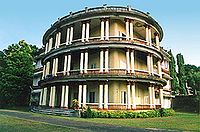- Cochin royal family
-
The Cochin Royal Family were rulers of Cochin, or Kochi, India. They were also known as Perumpadapu Swaroopam or Kuru Swaroopam.
Contents
Tradition of Perumpadapu Swaroopam
Traditionally Perumpadappu Moopil is considered as the political head of all the Brahmins in Kerala (spiritual head being Azhvanchery Thamprakkal). Their rituals and tradition is almost similar to that of Brahmins with some exceptions like 12 days of Pollution on death or Birth, Veli not performed for marriages of male members, cannot do pooja yagam etc. Normally for Sandhya vandanam members recite 10 Gayatri mantrams. Among the ruling families in kerala only members of Perumpadappu swaroopam traditionally had the right to Serve feast to Brahmins or can have food together with Brahmin(thachudya kaimal of kudalmanikya kshetram also have that right). This can be verifed by reading Shaktan Thampuran story in Ayithihyamaala of kottarathil Shankunni.We can see there is a strong relation of Cochin dynasty with the Christian community.The elephant lamp presented by Shaktan Thampuran to the Saint Mary's Church, Kanjoor proving the above fact. Every member has to do Shodasakriyakal. The term "Shodasakriyakal" refers to sixteen rites to be performed by all members, as structured through "Smruthi".
- Sekom (Garbhaadhaanam) : A rite to be performed just before the first sexual intercourse after marriage.
- Pumsavanom : To be performed just after conception.
- Seemantham : Performed after Pumsavanom.
- Jathakarmam : Performed just after birth.
- Naamakaranam : Naming Ceremony of the child.
- (Upa)nishkramanam (Vaathilpurappadu) : Involves taking the child out of the house for the first time.
- Choroonu : The first ceremonial intake of rice by the child.
- Choulam : The first hair-cut ceremony of the boy/ girl.
- Upanayanam : (Only for boys).
- Mahaanamneevrutham (Aanduvrutham) :
- Mahaavrutham :
- Upanishadvrutham :
- Godaanam : Rites as part of thanks-giving to the Aacharyan (priest or teacher).
- Samaavarthanam : A long ritual for the completion of the above said Vedic education.
- Marriage
- Agniadhaanam : A rite performed as an extension of Oupaasanam and introduction to Sroutha rites.
Deities
- Paradevatha (goddess): Vannery Chitrakoodam, Pazhayannur Bhagavathy, Chazhur Pazhayannur Bhagavathy
- Paradevan (god): Vishnu (Sree Poornathrayeesa), Tiruvanchikulathappan (Lord Shiva of Thiruvanchikulam between North Paravur and Kodungallore)
- Other Deities: Chottanikkara Bhagavathy, Pulpalli Thevar and many
Marriage
Traditionally the female members of the family are married (Sambandham) only to Namboodiri Brahmins while male members marry ladies of the Nair/Samanthan class. These wives of the male members are not Ranis as per the matriarchal system but instead get the title of Nethyar Amma. But today with Namboothiris marry within their class Perumpadappu Swaroopam members marry from other Malayala Kshatriyas class in Kerala. Traditionally the rule for marriage is females marry from same class (like thirupad) or class above (Namboothiri) and males marry from same class (like thirupad) or Nairs.
Naming practice of male Thampuran
In Cochin Royal Family all the male Thampurans were named according to the following methodology.
- Eldest Son To A Mother Goda Varma (No Longer Used)
- Second Son Rama Varma
- Third Son Kerala Varma
- Fourth Son Ravi Varma.
From then on to till date the last three naming convention is followed. But the name Goda varma is followed in the other root family (moola thavazhi) of cochin royal family namely chazur kovilakam. Reference – Genealogy of Cochin Royal Family
Naming practice of female Thampuran
In Cochin Royal Family the female Thampurans were named according to the following methodology.
- Eldest daughter To A Mother – Amba
- Second daughter – Ambika
- Third Daughter – Subhadra
This naming convention is followed again to third daughter and fourth etc.
Both the female and male members are called by the name "Thampuran" and have same last name(Thampuran). (in all other royal families in Kerala, males are called Thampuran and females – Thampuratti. For more details, please visit [1])[citation needed]
See also
Further reading
- Genealogy of Cochin Royal Family – By Rameshan Thampuran
References
External links
- Emergence Of Kingdom Of Cochin And Cochin Royal Family
- Cochin Royal Family Historical Society
- Namboothiri Websites Trust Calicut
Kerala topics History Sangam period · Edakkal Caves · Chera · Kerala school · Battle of Kulachal · Anglo-Mysore Wars · Vaikom Satyagraham · Perumpadapu Swaroopam · Malabar Migration ·Government
PoliticsAgencies · Chief Ministers · Governors · Legislative Assembly · Panchayat elections · Left Democratic Front · United Democratic Front · PoliticiansGeography Agasthyamala Biosphere Reserve · Annamalai Hills · Backwaters · Districts · Eravikulam National Park · Flora and fauna · Malabar Coast · Marayoor · Nelliampathi Mountains · Nilgiri Biosphere Reserve · Nilgiri Hills · Palakkad Gap · Protected areas · Vembanad LakeDemographics
Economy
ReligionMalayalis · Namboothiris · Ambalavasis · Samanthas · Nairs · Syrian Malabar Nasranis · Kerala Iyers · Ezhavas · Cochin Jews · Pulayar · Dravidians · Mappilas · Paradesi Jews · Adivasis · Sephardic Jews in Kerala · Scheduled Tribes · Kerala model · Tourism · Education (colleges and universities)Culture Dance / Drama / CinemaKathakali · Kolkali · Koodiyattam · Mohiniyattam · Margamkali · Ottamthullal · Theyyam · Cinema of KeralaFestivalsLanguagesChenda (Thayambaka) · Duff muttu · Mappila paattukal · Oppana · Panchari melam · Panchavadyam · SopanamOrganizations/AgenciesTourism Alappuzha · Athirappilly Falls · Beaches in Kerala · Kerala Backwaters · Kovalam · Munnar · Tourism in Thiruvananthapuram · Vallamkali · Wayanad · Bekal ·Portal Categories:- People from Kochi
- Indian Princely States
- History of Kerala
- Empires and kingdoms of India
- Historical Indian regions
- Dynasties of India
- History of Kochi
Wikimedia Foundation. 2010.




